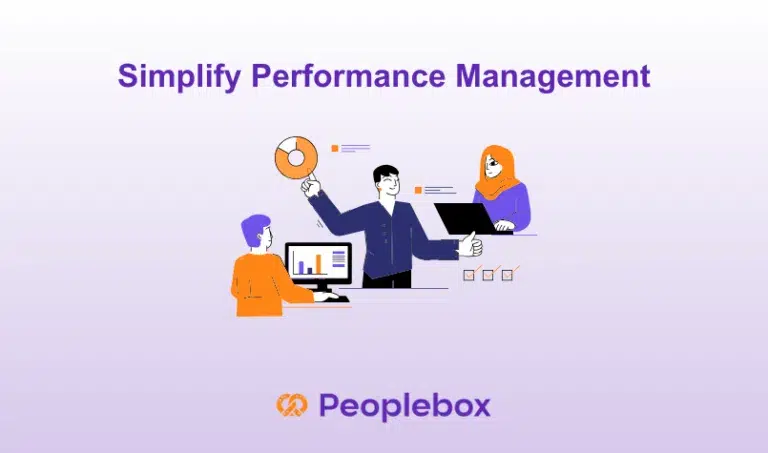If you’ve been following our blog, you’ll know that conducting effective performance reviews is a crucial aspect of employee growth and development. However, without a structured approach, these reviews can quickly become disorganized and inefficient. When performance reviews lack structure, they can lead to inconsistent feedback, missed opportunities for improvement, and a lack of actionable insights for employees. This is especially true in the case of 360-degree feedback.
This is why we have created the ultimate 360 degree feedback template to streamline your review process. But before that, let’s revisit the basics!

💡 What is a 360 degree review?
A 360 degree review, also known as a 360-degree feedback or multi-rater feedback, is a performance appraisal method that gathers feedback from multiple sources to provide a comprehensive and well-rounded assessment of an employee’s performance. We talk all about 360 degree performance reviews in our recent blog post. Check it out.
Components of the 360 Degree Review Template
A well-structured 360 degree review template typically consists of several key sections that collectively provide a comprehensive evaluation of an individual’s performance and skills. Let’s delve into the essential components of a 360 degree review template:
Self-Assessment Section
The self-evaluation section is a critical component of the 360 degree review process as it encourages employees to reflect on their own performance, strengths, weaknesses, and areas for improvement. Self-assessment fosters self-awareness, accountability, and personal development. It allows individuals to align their perceptions of their performance with the feedback received from others, facilitating a more holistic understanding of their capabilities and areas needing growth.
Best practices for writing self-assessments include:
- Be honest and transparent: Provide an accurate and honest assessment of your performance, highlighting both strengths and weaknesses.
- Focus on behaviors: Instead of making general statements, focus on specific behaviors or actions that contributed to your performance.
- Set goals for improvement: Identify areas for improvement and set specific, measurable, and achievable goals for growth.
Peer Feedback Section
Peer reviews play a crucial role in the 360 degree review process by providing insights into an individual’s interpersonal skills, teamwork, communication, and collaboration abilities. Colleagues who work closely with the individual can offer valuable perspectives on how they interact within the team, contribute to group dynamics, and support their peers.
Peer feedback helps identify patterns of behavior, strengths, and areas for improvement that may not be apparent from a single perspective.
Best practices for writing peer reviews include:
- Be specific and detailed: Provide specific examples of the individual’s strengths and weaknesses, highlighting both positive and negative behaviors.
- Focus on behaviors and actions: Instead of making general statements, focus on specific behaviors or actions that contributed to the individual’s performance.
- Provide actionable feedback: Offer constructive feedback that is actionable and tied to specific goals or objectives.
Manager Feedback Section
Feedback from managers is essential for evaluating an individual’s leadership potential, performance, and alignment with organizational goals. Supervisors can provide valuable insights into an employee’s strategic thinking, decision-making, goal achievement, and overall effectiveness in their role.
Manager feedback helps employees understand how their actions and behaviors impact their team and the organization, guiding them towards professional growth and development.
Here are some tips for writing manager feedback:
- Focus on performance and goals: Evaluate the individual’s performance based on specific goals and objectives, highlighting both achievements and areas for improvement.
- Provide context: Provide context for your feedback by explaining how the individual’s performance impacts the team and the organization.
- Offer support and resources: Offer support and resources to help the individual improve in areas where they need development.
Direct-report Feedback Section
Receiving feedback from direct reports is a valuable aspect of the 360 degree review process, especially for managers and leaders. Subordinate feedback offers insights into a manager’s communication style, approachability, delegation skills, and overall effectiveness in leading and supporting their team.
Understanding how one is perceived by their direct reports can help managers identify blind spots, improve their leadership practices, and build stronger, more collaborative relationships within the organization.
Best practices for writing direct-report reviews include:
- Focus on leadership and management: Evaluate the manager’s leadership and management skills, highlighting both strengths and areas for improvement.
- Provide specific examples: Provide specific examples of how the manager’s leadership skills and management style impact their team and the organization.
- Offer suggestions for improvement: Offer suggestions for improvement that are actionable and tied to specific goals or objectives.
Sample Questions for 360 Degree Review Template (Just Copy and Paste)
When conducting a 360 degree review, the quality of the questions asked plays a crucial role in gathering valuable employee feedback. Here are sample 360 degree feedback questions tailored for each type of feedback that you could just copy and paste (Don’t forget to customize it to your organization’s need).
Self-Assessment Questions:
- What are your key strengths and areas for improvement?
- How do you perceive your communication skills in the workplace?
- What goals have you set for yourself, and how are you progressing towards them?
- How do you handle feedback and criticism from others?
- In what areas do you feel you have excelled in the past year, and why?
Peer Feedback Questions:
- How would you describe the individual’s teamwork and collaboration skills?
- What impact does the individual have on team morale and dynamics?
- How effectively does the individual communicate with team members?
- In what ways does the individual contribute to the success of team projects?
- Can you provide an example of a situation where the individual demonstrated leadership qualities?
Manager Feedback Questions:
- How well does the individual meet performance expectations and goals?
- What areas of the individual’s work could be improved to enhance overall performance (e.g., time management, decision-making, problem-solving)?
- How does the individual handle challenges and setbacks in their role?
- What support or resources could help the individual excel in their current position?
- How does the individual respond to feedback and coaching from their superiors?
Direct Report Feedback Questions:
- How effective is the individual in providing clear direction and guidance?
- How does the individual understand the team’s needs and support your professional growth and career development?
- What areas of the individual’s leadership style could be enhanced?
- How well does the individual communicate expectations and provide feedback?
- Can you share an example of a time when the individual successfully resolved a conflict within the team?
These sample questions are designed to prompt thoughtful and constructive feedback from different perspectives, providing a comprehensive view of an individual’s performance and areas for development. Feel free to customize these questions to align with your organization’s specific goals and competencies.
If you’re looking for more 360 degree review questions, check out our exclusive blog post on the essential 360 degree performance questions you can use right away!
Free Customizable 360 Degree Review Template
To help you streamline your 360 degree feedback process, we have created a free performance review template with survey questions that you can use to gather performance feedback from multiple sources. Download the template, customize it to suit your organization’s needs, and use it to collect comprehensive and balanced feedback on your employees’ performance.

Conduct Effective 360 Degree Reviews with Peoplebox
If you’re looking to implement 360 degree reviews within your organization, consider switching to Peoplebox, a cutting-edge performance management platform designed to streamline the process and drive employee growth. Peoplebox offers a user-friendly interface, customizable performance management templates, and robust analytics to help you gather comprehensive feedback, identify areas for improvement, and foster a culture of continuous learning. Try it yourself!
With Peoplebox, you can easily manage the performance review process, track progress, and generate insightful reports to make data-driven decisions that support employee development and organizational success. Whether you’re a small startup or a large enterprise, Peoplebox has the tools and features to help you conduct effective 360 degree reviews and unlock the full potential of your workforce.
Ready to start your journey towards a more engaged, high-performing team? Talk to us today!







